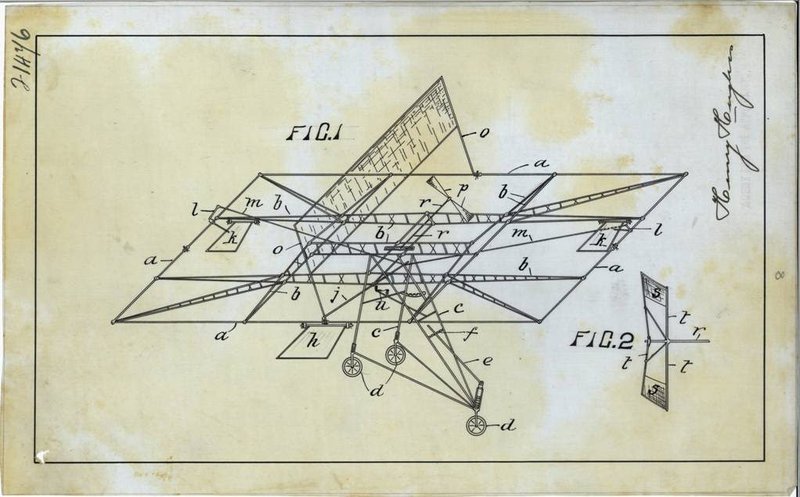A replica of the aircraft designed and built by Richard Pearse, a young farmer with no formal engineering training but with remarkable analytical aptitude and genius, stands as a memorial to his pioneering engineering achievement.

The Richard Pearse Memorial. Photo: Engineering New Zealand, 2011.
Early experimentation
Pearse’s family could not afford to send him to Canterbury College to study engineering. Instead he was given the use of a nearby farm block. He built a workshop and devoted his time to inventing.
Pearse described how “from the time I was quite a little chap I had a great fancy for engineering, and when I was still quite a young man I conceived the idea of inventing a flying machine.”
There is some debate about the date of Pearce’s first flight attempt and whether or not he achieved controlled powered flight. 31 March 1903 is generally agreed as the date of his first attempt. He travelled a short distance in the air before coming to rest on top of a gorse hedge.
The flying machine
Regardless of his success in the air, Pearce’s flying machine was a remarkable achievement. It was a high wing monoplane with a frame of bamboo and canvas covered wings. The tricycle undercarriage was of light steel tubing. Special features included wing flaps, rear elevator, a steerable nosewheel and a propeller with variable-pitch blades. The most impressive feature was the internal combustion engine which Pearse designed and constructed himself from cast iron irrigation pipe. He recognised the need to achieve a high power to weight ratio and continued to refine his engine design over many years.
Pearse patented his first aircraft design in 1906. In a newspaper article of 30 November 1909, Pearse described how he had been working on his current prototype for the past five years. He made special mention of the engine, which he described as a 25hp water-cased engine in four parts, weighing 100lbs and able to turn the propeller blades at 800 revolutions per minute.

This drawing was part of Pearse’s 1906 patent application, now held at Archives New Zealand. Archives reference: ABPJ W4832 7396 Box 17 / 87637. https://www.flickr.com/photos/archivesnz/8780298378. Creative Commons Attribution (BY) 2.0 CC International license.
Remembering Pearse
Pearse did not receive public acclaim during his lifetime but over the decades following has captured a place in the public imagination as New Zealand’s pioneer aviator.
His story has been told in documentaries, television dramatisations and books. In 1990 he was commemorated with a special postage stamp. The Richard Pearse Memorial, including replica monoplane, sits just off Main Waitohi Road, Canterbury, at the site where Pearce is said to have landed on a hedge in his first attempt at flight.
More information
References
“A Flying Machine”. Clutha Leader, 30 November, 1909, 6.
Aimer, Peter. "Aviation - The beginnings of aviation", Te Ara - the Encyclopedia of New Zealand, www.TeAra.govt.nz/en/postage-stamp/6562/commemorating-new-zealands-first-flight (accessed 28 March 2019)
NZ on Screen."Off the Ground - 1, The First to Fly". Television documentary, 1982. www.nzonscreen.com/title/off-the-ground-the-first-to-fly
NZ on Screen. "Richard Pearse". Television drama, 1975. www.nzonscreen.com/title/richard-pearse-1975
Ogilvie, Gordon. The riddle of Richard Pearse: the story of New Zealand's pioneer aviator and inventor. Auckland: Reed. 4th ed. 2003.
Ogilvie, Gordon. "Pearse, Richard William", Dictionary of New Zealand Biography, first published in 1996. Te Ara - the Encyclopedia of New Zealand, teara.govt.nz/en/biographies/3p19/pearse-richard-william (accessed 28 March 2019)
Rodliffe, C. Geoffrey. Richard Pearse: pioneer aviator. Auckland: Published in association with the Museum of Transport and Technology and Richard Pearse Memorial Committee, Centennial edition, 2003.
Rodliffe, C.G. Wings over Waitohi: the story of Richard Pearse. Auckland: C.G. Rodliffe in association with Avon Press. 2nd ed. 1997
Access
The memorial is located on Main Waitohi Road, Waitohi, Canterbury, near the site of Pearse's first flight attempt.
When travelling along State Highway One take the westward turn-off immediately south of Temuka township (Waitohi Temuka Road). Follow this road through Waitohi township. Soon after the memorial can be seen in a lay-by on the north side of the road.

